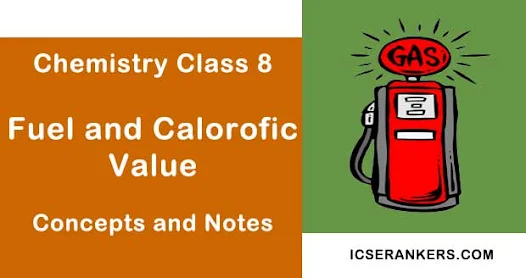Fuel and Calorific Value- Chemistry Guide for Class 8
Information about Fuel and Calorific Value
Title | Fuel and Calorific Value |
Class | Class 8 |
Subject | Class 8 Chemistry |
Topics Covered |
|
Fuel and Calorific Value
- The amount of heat energy produced on completely burning one kilogram of a fuel in pure oxygen is called the calorific value of a fuel.
- A fuel which produces more heat energy per kilogram is said to have a higher calorific value. The more the calorific value, the better is the efficiency of a fuel.
- Calorific value is expressed in kilojoules per kilogram (kJ/kg).
Characteristics of a Good Fuel
A good fuel should:
- be cheap, readily available and easy to transport.
- be easy to store.
- have a high calorific value.
- not produce harmful gases after burning.
- have a low ignition temperature; however, this should not be below, or around, the room temperature.
- undergo complete and controllable combustion.
Among the different physical state of fuels, fuels in the gaseous state are generally the best. This is because of the reasons listed here:
- Gaseous fuels are supplied in cylinders, or though pipeline. Hence, their transportation cost gets lowered.
- Gaseous fuels release large amount of energy; they also do not leave behind any ash or solid residue on combustion.
- Gaseous fuels produce least amount of harmful gases as compared to solid and liquid fuels.
- Gaseous fuels can be easily ignited even with a small spark. Their rate of combustion can also be (easily) controlled with the help of a control valve.
Harmful Effects of Fuels
Increased fuel consumption has led to harmful effects on the environment in the following ways:
- Fuels, like wood, coal and petroleum products, release unburnt carbon particles. These carbon particles of smoke, or ash, get suspended in the air. Excessive amount of these particles in the air causes breathing problems. In winter, these particles produce 'smog' which is very harmful to plants as well as animals.
- Incomplete combustion of carbon fuels results in the formation of carbon monoxide gas. It is a very poisonous gas. Even small amounts of carbon monoxide, in air, can cause breathing problems; large amounts of it can prove fatal.
- Combustion of (most) fuels releases carbon dioxide in the environment. Excess of carbon dioxide, in air, can trap heat energy which can raise the temperature of the earth. This is termed as global warming. This can result in the melting of polar glaciers, which, in turn, can lead to a rise in the sea level, causing floods in the coastal areas.
- Burning of coal and diesel releases sulphur dioxide gas. It is an extremely suffocating gas. It also dissolves in water vapour to produce sulphuric acid. When it rains, the acid, thus produced, can damage buildings, plants and trees. Such rain is called acid rain.
The use of diesel and petrol as fuels, in automobiles, is being replaced by CNG (Compressed Natural Gas). This is because CNG produces less harmful products and is, therefore, a more eco-friendly and cleaner fuel.
Some Important Terms
- calorific value of a fuel: the amount of heat energy, produced on complete burning of one kilogram, of a given fuel, in pure oxygen.
- combustion: burning of a substance in the presence of oxygen to produce heat and light.
- combustible material: a material, which on heating in the presence of air (or oxygen), catches fire easily and produces heat and light energy.
- explosive combustion: complete and uncontrolled combustion of a substance within a short span of time.
- flame: the region of burning gases.
- ignition (or kindling) temperature: the minimum temperature at which a given substance begins to burn.
- innermost zone of a candle flame: the zone of unburnt wax vapours, given off by the molten wax.
- middle or luminous zone of a candle flame: the zone where there is a partial combustion of wax vapours with liberation of energy.
- outermost or non-luminous zone of a candle flame: the zone of complete combustion, of wax vapours and carbon particles, that is the hottest part of the flame.
- rapid combustion: when a substance burns at a fast rate to produce heat.
- spontaneous combustion: when a combustible substance catches fire, on its own, even at room temperature.


